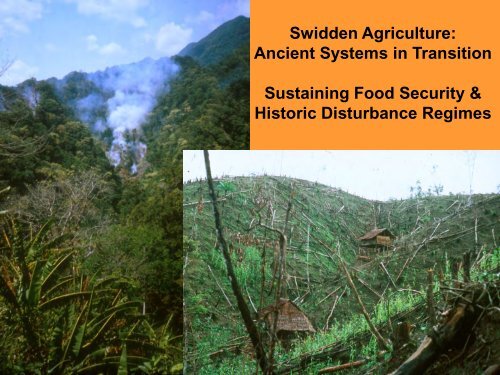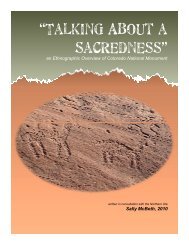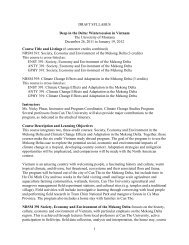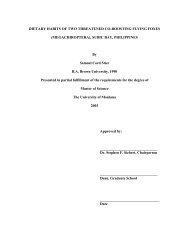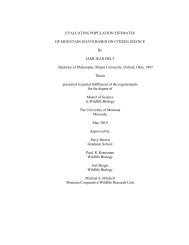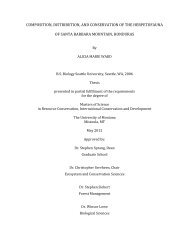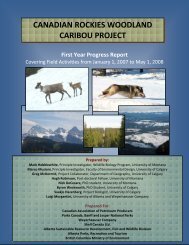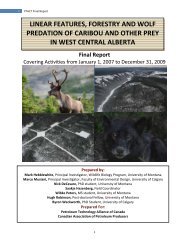Swidden Agriculture: Ancient Systems in Transition Sustaining Food ...
Swidden Agriculture: Ancient Systems in Transition Sustaining Food ...
Swidden Agriculture: Ancient Systems in Transition Sustaining Food ...
You also want an ePaper? Increase the reach of your titles
YUMPU automatically turns print PDFs into web optimized ePapers that Google loves.
<strong>Swidden</strong> <strong>Agriculture</strong>:<br />
<strong>Ancient</strong> <strong>Systems</strong> <strong>in</strong> <strong>Transition</strong><br />
Susta<strong>in</strong><strong>in</strong>g <strong>Food</strong> Security &<br />
Historic Disturbance Regimes
<strong>Swidden</strong> farm<strong>in</strong>g, also know as shift<strong>in</strong>g cultivation or milpa <strong>in</strong> Lat<strong>in</strong> America, is<br />
conventionally def<strong>in</strong>ed as “an agricultural system <strong>in</strong> which temporary clear<strong>in</strong>gs are<br />
cropped for fewer years than they are allowed to rema<strong>in</strong> fallow” (Sanchez, 1976). While<br />
certa<strong>in</strong>ly correct, this def<strong>in</strong>ition reflects a Western or modern emphasis on the relatively<br />
short period when annual food and other crops are grown. <strong>Swidden</strong> can also be thought<br />
of as forest farm<strong>in</strong>g, s<strong>in</strong>ce the fallow period is typically long, managed and often<br />
cultivated as well, although with perennial species rather than annuals.<br />
Irrespective of the emphasis, swidden is a rotational form of agriculture that applies<br />
natural vegetative processes as a means of replenish<strong>in</strong>g soil fertility and controll<strong>in</strong>g<br />
<strong>in</strong>vasive weeds. The practice evolved <strong>in</strong>dependently throughout the world and varies <strong>in</strong><br />
response to site-specific ecological, socio-economic and cultural conditions. <strong>Swidden</strong><br />
systems have proven to be productive and susta<strong>in</strong>able adaptations to challeng<strong>in</strong>g<br />
environmental conditions that feature high labor productivity at low population densities<br />
(Cairns, 2007). <strong>Swidden</strong> agriculture, often pejoratively called slash and burn, has had a<br />
poor reputation and been actively suppressed from colonial to contemporary times.<br />
In this powerpo<strong>in</strong>t, I consider swidden practices utiliz<strong>in</strong>g the framework developed by<br />
the classic swidden researcher, Dr. Hal Conkl<strong>in</strong> (1957). He differentiated two shift<strong>in</strong>g<br />
cultivation systems: 1) <strong>in</strong>tegral, which he described as productive, susta<strong>in</strong>able, carefully<br />
regulated and managed through social norms, cultural traditions and religious practices<br />
and that <strong>in</strong>corporated rich traditional ecological knowledge and practice and 2) <strong>in</strong>cipient ,<br />
which are more <strong>in</strong>tensive, destructive and unsusta<strong>in</strong>able practices often used by recent<br />
migrants who lack site-specific TEKP and have little management capacity. I consider<br />
explanations for the breakdown of <strong>in</strong>tegral swidden systems, and what contemporary<br />
agriculture, conservation and development efforts might learn from these age-old forest<br />
farm<strong>in</strong>g practices.
fallow<br />
regrowth<br />
plant<strong>in</strong>g<br />
<strong>Swidden</strong> Cycle (<strong>in</strong>tegral/long fallow)<br />
Cultivation:fallow lengths and specific practices <strong>in</strong><br />
<strong>in</strong>tegral swidden systems vary with site-specific soil,<br />
climatic and related biophysical factors and the<br />
socioeconomic needs and cultural traditions of farmers.<br />
In the humid tropics where soils are highly weathered<br />
and decomposition rates rapid, 1-2 yrs of cultivation,<br />
followed by 15-20 yrs of fallow are required to ma<strong>in</strong>ta<strong>in</strong><br />
productivity and avoid establishment of <strong>in</strong>vasive weeds.<br />
clear<strong>in</strong>g<br />
dry<strong>in</strong>g<br />
burn<strong>in</strong>g
Key characteristics of <strong>in</strong>tegral swidden systems <strong>in</strong>clude:<br />
• a short cultivation period followed by a long fallow, 1-2 yrs<br />
cultivation:15-20 yrs fallow is common <strong>in</strong> the humid tropics<br />
• cultivation:fallow lengths vary with soils, climate & elevation<br />
• <strong>in</strong> temperate high<br />
elevation Bhutan<br />
a 3:4 yr cycle with<br />
grass & shrub<br />
fallow was used to<br />
cultivate barley,<br />
buckwheat &<br />
vegetables on a<br />
susta<strong>in</strong>able basis<br />
for centuries<br />
Clear<strong>in</strong>g 10-15 yr old<br />
secondary growth <strong>in</strong><br />
fallowed swidden,<br />
San Vicente, Leyte.
In <strong>in</strong>tegral swidden systems<br />
farm parcels tend to be small<br />
(0.25 – 1.0 ha) which is about<br />
the same size of natural (i.e.,<br />
w<strong>in</strong>d throw) tree fall gaps <strong>in</strong><br />
tropical forests. Secondary<br />
vegetation that has<br />
established over the 15-20<br />
year fallow is cleared by hand<br />
and some trees are reta<strong>in</strong>ed<br />
due to their large size or<br />
value for fruit, timber and<br />
other uses. <strong>Swidden</strong><br />
cultivation and fallow<br />
products may be consumed<br />
directly by households or<br />
marketed for cash <strong>in</strong>come.<br />
Farmer beneath a large Ficus sp.<br />
reta<strong>in</strong>ed <strong>in</strong> a swidden field, San<br />
Vicente<br />
�
Dry<strong>in</strong>g<br />
A primary objective <strong>in</strong> swidden is to convert<br />
nutrients accumulated <strong>in</strong> biomass dur<strong>in</strong>g the fallow<br />
to a form (i.e., ash) that can be taken up by crops.<br />
The first step is to cut the secondary growth and<br />
allow it to dry before the arrival of the ra<strong>in</strong>y season<br />
when crops are planted. The tim<strong>in</strong>g of these<br />
activities varies with local climatic conditions and<br />
unique local adaptations abound. For example, <strong>in</strong><br />
per-humid environments, such as New Gu<strong>in</strong>ea<br />
where there is no dry season, farmers are unable to<br />
burn. Instead they cut and mulch (i.e., compost) to<br />
release nutrients <strong>in</strong> biomass.<br />
San Vicente
Men are reportedly responsible for<br />
burn<strong>in</strong>g <strong>in</strong> most swidden systems,<br />
but women are capable as well;<br />
San Vicente<br />
Immediate post-burn condition<br />
well-suited for plant<strong>in</strong>g; note that<br />
only leaves and small twigs were<br />
consumed<br />
Burn<br />
The burn<strong>in</strong>g practices of <strong>in</strong>tegral swidden cultivators are<br />
sophisticated, carefully managed and reflect generations of<br />
accumulated traditional ecological knowledge and practice (TEKP).<br />
Burns are timed to co<strong>in</strong>cide with the anticipated arrival of the wet<br />
season. Decisions of when and how to burn on any given day take<br />
<strong>in</strong>to account humidity, temperature, w<strong>in</strong>d, and other factors. In San<br />
Vicente, swiddens are burned <strong>in</strong> the late morn<strong>in</strong>g when humidity is<br />
low, but before afternoon heat and w<strong>in</strong>ds develop. The objectives<br />
are to: 1) prepare a clean plant<strong>in</strong>g bed, 2) release nutrients <strong>in</strong> the<br />
biomass and make them available to crops as ash, 3) reduce <strong>in</strong>sects,<br />
fungi & diseases, and 4) elim<strong>in</strong>ate weeds. A good fire is quick, hot<br />
and consumes all leaves and small branches (where the majority of<br />
nutrients are stored), but is not so hot that it volatilizes nutrients or<br />
burns valuable soil organic matter.
Soil responses to<br />
burn<strong>in</strong>g:<br />
• <strong>in</strong>crease exchangeable<br />
cations (Ca, Mg)<br />
• <strong>in</strong>crease pH<br />
• decrease Al<br />
Duration of effects<br />
vary with:<br />
• soils<br />
• climate<br />
• <strong>in</strong>puts (fallow)<br />
• cultivation &<br />
management practices<br />
Sanchez (1976)
Plant<strong>in</strong>g<br />
Plant<strong>in</strong>g occurs immediately after burn<strong>in</strong>g and the arrival of ra<strong>in</strong>s. This ensures that nutrients<br />
released from biomass are taken up by crops, rather than be<strong>in</strong>g lost to runoff, leach<strong>in</strong>g or uptake by<br />
regrow<strong>in</strong>g secondary vegetation. Crop selection and management practices are as varied as the<br />
world’s cultures and environments and reflect household needs, preferences and labor availability;<br />
cultural and religious traditions; economic opportunities; local environmental conditions and many<br />
other factors. In Central America farmers have cultivated maize, beans & squash (the “3 sisters” )<br />
s<strong>in</strong>ce at least the time of the classic Maya. Intercropp<strong>in</strong>g these three annuals optimizes the use of<br />
space and light (beans are supported by maize, squash makes a complete ground), reduces erosion<br />
and runoff risks, fixes nitrogen, and produces foods that are nutritious and a complete source of<br />
prote<strong>in</strong>. A wide variety of vegetables and perennial crops may be <strong>in</strong>corporated at the time of plant<strong>in</strong>g<br />
or later dur<strong>in</strong>g cultivation and fallow periods.<br />
Plant<strong>in</strong>g <strong>in</strong> swidden systems is<br />
done with the use of a dibble<br />
stick (a heavy wooden pole).<br />
Holes are punched <strong>in</strong> the<br />
ground, seeds deposited, and<br />
the soil sealed with one’s foot.<br />
The absence of plow<strong>in</strong>g<br />
ma<strong>in</strong>ta<strong>in</strong>s an <strong>in</strong>tact and<br />
functional soil organic mat,<br />
m<strong>in</strong>imizes erosion and runoff,<br />
and facilitates secondary<br />
vegetation regrowth.<br />
young corn, San Vicente;<br />
note extensive roots & stump<br />
which will coppice/sprout and<br />
the <strong>in</strong>tact root mat
Management<br />
<strong>Swidden</strong> management practices,<br />
<strong>in</strong>clud<strong>in</strong>g the location and size of fields, the<br />
duration and compositioni of fallows, and<br />
many other factors, were historically<br />
managed and regulated by community<br />
norms and village elders, and <strong>in</strong>formed by<br />
TEKP. Integral swidden systems are<br />
“<strong>in</strong>tegrated” with local social, cultural and<br />
religious traditions. They also reflect<br />
household needs, <strong>in</strong>terests, available labor;<br />
economic and market opportunities; land<br />
availability; government policies; and many<br />
other factors.<br />
At the most basic level, the objectives of<br />
swidden cultivators are to: 1) ma<strong>in</strong>ta<strong>in</strong> a<br />
productive and susta<strong>in</strong>able agricultural<br />
system through manag<strong>in</strong>g soils and<br />
vegetation, 2) meet household food and<br />
<strong>in</strong>come needs, and 3) m<strong>in</strong>imize the risk of<br />
crop failures by plant<strong>in</strong>g a diversity of<br />
annual and perennial crops <strong>in</strong> space and<br />
time.<br />
Absolam weed<strong>in</strong>g <strong>in</strong>vasive Imperata<br />
cyl<strong>in</strong>drica grass, San Vicente
Weed management<br />
Weeds rarely establish or adversely affect crop yields <strong>in</strong> <strong>in</strong>tegral, long fallow swidden systems. A short<br />
cultivation : long fallow prevents establishment of grasses, composites and other weed species. Fields<br />
are fallowed when yields beg<strong>in</strong> to decl<strong>in</strong>e and weed<strong>in</strong>g requirements <strong>in</strong>crease. If cultivation periods are<br />
lengthened or fallows shortened, disturbance associated <strong>in</strong>vasive species can quickly establish.<br />
Throughout Southeast Asia, excessive cultivation, shortened fallows, logg<strong>in</strong>g and other disturbances<br />
have led to widespread establishment of exotic <strong>in</strong>vasive weeds. One of the most problematic species is<br />
Imperata cyl<strong>in</strong>drica, a grass of African orig<strong>in</strong>. Why might a grass from Africa be particularly well adapted<br />
to anthropogenic disturbances?<br />
Siebert (1987)
Crops<br />
<strong>Swidden</strong> farmers typically plant a wide<br />
variety of crop species and varieties, <strong>in</strong>clud<strong>in</strong>g<br />
annuals and perennials. This may <strong>in</strong>clude<br />
rattan, fruit, timber & other tree species. High<br />
species/varietal diversity reduces the risk of<br />
crop failure due to <strong>in</strong>sects, diseases or fungi,<br />
and yields products that meet a variety of<br />
domestic and market needs. For example,<br />
farmers <strong>in</strong> Southeast Asia cultivate many<br />
different rice varieties due to their variable<br />
drought, <strong>in</strong>sect and disease tolerances and<br />
desirability for specific uses, <strong>in</strong>clud<strong>in</strong>g brew<strong>in</strong>g<br />
alcohol (arak).<br />
Plants are <strong>in</strong>tensively and sequentially<br />
<strong>in</strong>tercropped to provide multiple and<br />
cont<strong>in</strong>uous yields dur<strong>in</strong>g cultivation and<br />
fallow periods. Rattan (Calamus caesius) was<br />
formerly cultivated as a swidden fallow crop <strong>in</strong><br />
Indonesian Borneo. It provided a lucrative<br />
cash crop when fields were next ready for<br />
cultivation or the parcel could be reta<strong>in</strong>ed as a<br />
rattan garden for decades, depend<strong>in</strong>g on<br />
household needs and cane market prices.<br />
swidden 1 yr after plant<strong>in</strong>g<br />
(sweet potato, banana, sugar<br />
cane, beans), San Vicente
Crops<br />
<strong>Swidden</strong> farmers cultivate crops for direct household consumption and for<br />
market/cash <strong>in</strong>come.<br />
bananas,<br />
San Vicente<br />
c<strong>in</strong>namon relay<br />
<strong>in</strong>tercrop, Ker<strong>in</strong>ci
Labor<br />
Labor <strong>in</strong>puts <strong>in</strong> swidden systems vary with gender, age, experience, crops<br />
cultivated, and cultural practices and traditions. Land clear<strong>in</strong>g, plant<strong>in</strong>g and<br />
and other farm<strong>in</strong>g practices can be performed <strong>in</strong>dividualy or collectively. In<br />
general, the labor required <strong>in</strong> long fallow swidden systems is low <strong>in</strong><br />
comparison to <strong>in</strong>cipient shift<strong>in</strong>g cultivation or permanent farm<strong>in</strong>g systems<br />
because little time or effort is required <strong>in</strong> weed<strong>in</strong>g.<br />
women’s work group plant<strong>in</strong>g corn, San Vicente
<strong>Swidden</strong> fallow vegetation <strong>in</strong>cludes:<br />
natural secondary succession <strong>in</strong>tensively cultivated parcels<br />
species composition varies highly variable, reflect<strong>in</strong>g<br />
with cultivation <strong>in</strong>tensity, household needs, <strong>in</strong>terests,<br />
previous disturbance, labor availability, market<br />
presence of species, and access and opportunities,<br />
many other ecological factors knowledge, and many other<br />
factors<br />
2 yr old secondary forest, Sulawesi rattan seedl<strong>in</strong>gs to swidden fallow, Borneo
Soil responses to cultivation:<br />
• vary with cultivation and fallow<br />
lengths and burn <strong>in</strong>tensities<br />
General effects over time <strong>in</strong>clude:<br />
• < pH, nutrients & organic matter<br />
• > weeds<br />
� yields decl<strong>in</strong>e<br />
� land fallowed<br />
� vegetation regrowth<br />
� nutrient accumulate<br />
<strong>in</strong> biomass, weeds<br />
suppressed<br />
<strong>in</strong> San Vicente swiddens<br />
Siebert (1987)
Summary attributes of <strong>in</strong>tegral swidden systems<br />
• adapted to nutrient limited sites (esp. acid, <strong>in</strong>fertile tropical soils)<br />
• wide climatic adaptability (seasonally dry � perhumid)<br />
• vegetation <strong>in</strong>cludes:<br />
- crops – highly variable, site-specific, production for hh & market<br />
- fallow – bush (3-5 yr) � forest (15-20 yr), site & climate dependent<br />
- weeds – m<strong>in</strong>imal if long fallow<br />
• native flora, ecosystem processes & regeneration paths ma<strong>in</strong>ta<strong>in</strong>ed<br />
• natural/biological control of <strong>in</strong>sects & disease pathogens<br />
• high biodiversity conservation value (habitat & connectivity)<br />
• use & management:<br />
- relatively low capital & labor<br />
- knowledge & experience <strong>in</strong>tensive (TEKP)<br />
- regulated via social norms, cultural traditions & religious practices
Incipient slash and burn farm<strong>in</strong>g<br />
Integral long fallow swidden systems are now largely a memory. Inhabitants of a few remote<br />
areas <strong>in</strong> Amazonia and Southeast Asia may still practice <strong>in</strong>tegral swidden, but elsewhere these<br />
systems have disappeared as a result of cultural change, lack of available land, emerg<strong>in</strong>g market<br />
opportunities, destructive logg<strong>in</strong>g practices, establishment of large plantations, government policies,<br />
and competition with recent migrants who lack the requisite TEKP. Integral swidden practices have<br />
been replaced by what Conkl<strong>in</strong> called <strong>in</strong>cipient shift<strong>in</strong>g cultivators, or what others refer to as slash<br />
and burn.<br />
Incipient slash and burn<br />
farm<strong>in</strong>g is characterized by:<br />
• a lack of knowledge and<br />
experience (TEKP),<br />
• cont<strong>in</strong>uous and/or more<br />
<strong>in</strong>tensive cultivation,<br />
• large clear<strong>in</strong>gs with few/no<br />
trees reta<strong>in</strong>ed,<br />
• no or short fallows, and<br />
• repeated burn<strong>in</strong>g<br />
Incipient slash and burn is<br />
unsusta<strong>in</strong>able, results <strong>in</strong><br />
widespread establishment of<br />
<strong>in</strong>vasive weeds and often<br />
creates a wave or front of<br />
forest conversion.<br />
Belize
Summary attributes of <strong>in</strong>cipient slash & burn:<br />
• destructive & unsusta<strong>in</strong>able, leads to extensive forest conversion<br />
• facilitates establishment of exotic <strong>in</strong>vasive species (e.g., Imperata cyl<strong>in</strong>drica)<br />
• widespread/global (tropical) phenomena<br />
Slash & burn<br />
frontier, Sulawesi
Integral swidden vs. Incipient slash & burn<br />
• long-term residents<br />
• rooted <strong>in</strong> culture, religion, traditions<br />
• extensive TEKP<br />
• self regulated/managed<br />
• long fallow<br />
• susta<strong>in</strong>able<br />
• land extensive<br />
San Vicente<br />
Sulawesi<br />
• recent migrants<br />
• not rooted <strong>in</strong> culture<br />
• little/no TEKP<br />
• largely unregulated<br />
• short/no fallow<br />
• unsusta<strong>in</strong>able<br />
• land <strong>in</strong>tensive
The many different factors and underyl<strong>in</strong>g forces responsible for tropical<br />
forest conversion and degradation have been debated for decades. Literally<br />
hundreds of books and articles have been written on the subject. In my op<strong>in</strong>ion,<br />
Geist & Lamb<strong>in</strong> (2002) provide one of the most thoughtful and useful analyses.<br />
Based on an analysis of 152 empirical studies, they suggest that it is important<br />
to differential between proximate causes (e.g., specific activities one observes <strong>in</strong><br />
the field) and underly<strong>in</strong>g driv<strong>in</strong>g forces (i.e., the socioeconomic, political and<br />
other factors that allow or facilitate actions observed <strong>in</strong> the field).<br />
Geist and Lamb<strong>in</strong> (2002) conclude that:<br />
• no universal cause:effect relationships expla<strong>in</strong> forest conversion/degradation<br />
• causes & driv<strong>in</strong>g forces are highly variable, site specific and diverse<br />
• key proximate causes <strong>in</strong>clude:<br />
- agricultural expansion<br />
- logg<strong>in</strong>g<br />
- <strong>in</strong>frastructure development (e.g., roads, dams, etc.)<br />
• key underly<strong>in</strong>g driv<strong>in</strong>g forces <strong>in</strong>clude:<br />
- economic opportunities<br />
- national & global policies<br />
• population growth & swidden cultivation have been overemphasized as a<br />
cause of tropical forest conversion and degradation
Underly<strong>in</strong>g driv<strong>in</strong>g forces of <strong>in</strong>cipient shift<strong>in</strong>g cultivation<br />
• lack of access to land, resources, or<br />
alternative/preferred livelihoods<br />
• state & <strong>in</strong>ternational development<br />
policies:<br />
- frontier development (e.g., Amazon)<br />
- transmigration (e.g., Indonesia)<br />
� displace resident populations,<br />
migrant practices <strong>in</strong>appropriate<br />
& unsusta<strong>in</strong>able due to lack TEKP<br />
• un<strong>in</strong>tended consequence of<br />
government failure to address<br />
socioeconomic problems elsewhere<br />
(e.g., land tenure <strong>in</strong>equity <strong>in</strong> Brazil)<br />
Javanense transmigrant,<br />
Sulawesi
Integral swidden systems can be thought of ecologically as historic<br />
anthropogenic disturbances whose specific attributes are reflected <strong>in</strong> and may<br />
be important to reta<strong>in</strong><strong>in</strong>g contemporary forest species composition, structure<br />
and ecosystem processes. Ecological disturbance attributes can be described<br />
<strong>in</strong> terms of their (modified from Uhl, 1990):<br />
• Type – e.g., small gaps (tree falls) or light burn (<strong>in</strong>tegral),<br />
• Size – impacts biophysical conditions (e.g., regeneration & microclimate)<br />
• Intensity/duration – e.g., fire temperature, years of cultivation, etc.<br />
• Frequency – return <strong>in</strong>terval (susta<strong>in</strong>able: 15-20 yrs), if shorter degradation<br />
• Distance - from undisturbed vegetation<br />
Differences between <strong>in</strong>tegral and <strong>in</strong>cipient swidden practices can be compared<br />
by describ<strong>in</strong>g their specific disturbance attributes and associated effects.<br />
Integral Incipient
Compar<strong>in</strong>g<br />
natural &<br />
anthropogenic<br />
disturbances<br />
• type<br />
• size/scale<br />
• <strong>in</strong>tensity<br />
• duration<br />
• frequency<br />
• effects are<br />
<strong>in</strong>teractive,<br />
cumulative and<br />
uncerta<strong>in</strong> due to<br />
natural &<br />
unpredictable<br />
environmental (e.g.,<br />
climate) & social<br />
(e.g., economic)<br />
changes<br />
Uhl (1990)
Regeneration of biomass follow<strong>in</strong>g disturbance<br />
Integral swidden<br />
with 15 yr<br />
fallow �<br />
Uhl (1990)<br />
� Incipient slash and burn
Regeneration <strong>in</strong> <strong>in</strong>tegral and <strong>in</strong>cipient swidden systems<br />
Uhl (1990)<br />
�Integral long fallow<br />
swidden systems<br />
�Incipient<br />
short fallow<br />
systems
Integral swidden practices have been opposed and suppressed by both<br />
colonial and post-<strong>in</strong>dependent governments around the world. Colonial and<br />
nation states directly and <strong>in</strong>directly suppressed <strong>in</strong>tegral swidden systems by:<br />
- ignor<strong>in</strong>g traditional land & resource rights <strong>in</strong> legal documents & cadastral<br />
surveys<br />
- grant<strong>in</strong>g concessions for logg<strong>in</strong>g & export cash crop plantations on<br />
ancestral lands of swidden cultivators which elim<strong>in</strong>ates the viability of<br />
land extensive long fallow swidden practices<br />
- encourag<strong>in</strong>g migration to avoid socioeconomic problems & land tenure<br />
<strong>in</strong>equities elsewhere (e.g., Brazil) or to provide plantation labor or<br />
pursue national development policies (e.g., transmigration <strong>in</strong> Indonesia)<br />
State opposition to <strong>in</strong>tegral swidden agriculture reflects:<br />
- ignorance, particularly re. its productivity, susta<strong>in</strong>ability and resilience<br />
- bias towards ‘modern’ <strong>in</strong>dustrial, agriculture<br />
- cultural/racial/development bias - many swidden societies are m<strong>in</strong>orities<br />
- desire to control populations for purposes of taxation and for cultivation<br />
export cash crops
The breakdown of <strong>in</strong>tegral swidden systems, many of which have<br />
proven to be productive and susta<strong>in</strong>able for centuries, results <strong>in</strong><br />
profound social, economic and cultural change. Some of the more<br />
significant changes <strong>in</strong>clude:<br />
• <strong>in</strong>creased labor (due to weed<strong>in</strong>g)<br />
• reduced crop yields (due to decl<strong>in</strong><strong>in</strong>g soil fertility and weeds)<br />
• <strong>in</strong>creased risk of crop losses<br />
Decl<strong>in</strong><strong>in</strong>g agricultural productivity and susta<strong>in</strong>ability can lead to:<br />
• reduced household food & livelihood security<br />
• <strong>in</strong>creased poverty<br />
• need for <strong>in</strong>come/alternative livelihoods, often as wage laborers<br />
where plantations have displaced swiddens<br />
• <strong>in</strong>creased conflict over decl<strong>in</strong><strong>in</strong>g forest/land resources, particularly<br />
where recent migrants compete with <strong>in</strong>digenous peoples<br />
• migration to new forest sites where available or to urban slums<br />
• breakdown of cultural traditions & community governance
Comparison of <strong>in</strong>tegral & <strong>in</strong>cipient swidden cultivation <strong>in</strong> terms of<br />
social & ecological resilience (Berkes, et al., 2003)<br />
The breakdown of natural & social adaptive cycles <strong>in</strong> <strong>in</strong>cipient systems results <strong>in</strong>:<br />
- loss of capital: nutrients, productivity, knowledge, management capacity<br />
- loss of ecological and social/cultural diversity, memory and redundancy<br />
The cumulative effect is reduced capacity (ecologically and socially) to adapt to<br />
unpredictable, but <strong>in</strong>evitable ecological and social change. System reorganization after<br />
disturbance/change has reduced capital, diversity, memory and redundancy upon which<br />
to rebuild. As a<br />
<strong>in</strong>tegral swidden systems – ma<strong>in</strong>ta<strong>in</strong> resilience<br />
consequence, system<br />
resilience and productivity<br />
are decl<strong>in</strong>e and a<br />
downward degradation<br />
spiral may ensue.<br />
<strong>in</strong>cipient slash & burn �<br />
- low resilience & reduced<br />
adaptive capacity due to<br />
loss of nutrients, TEKP, etc.
Historical legacies of swidden agriculture<br />
• ancient & pervasive – throughout much of tropics<br />
• example of co-evolution of natural & social systems<br />
• major <strong>in</strong>fluence on contemporary biodiversity, species composition,<br />
distribution, structure and on ecosystem functions & processes<br />
• <strong>in</strong>creases landscape heterogeneity &<br />
proportion early successional vegetation<br />
• <strong>in</strong>tegral systems are rich source of<br />
TEKP for develop<strong>in</strong>g productive &<br />
susta<strong>in</strong>able agricultural practices<br />
successional vegetation mosaic, Sulawesi Maya landscape, Belize
Discussion topics and questions:<br />
1) Susta<strong>in</strong>ability (ecological)<br />
a) what constra<strong>in</strong>s agricultural production <strong>in</strong> the tropics?<br />
b) how do swidden systems susta<strong>in</strong> crop yields?<br />
c) how do swidden practices vary under different soil and<br />
climatic conditions?<br />
d) <strong>in</strong> recent decades long fallow swidden systems have<br />
changed/broken down; what effect has this had on soils,<br />
flora, fauna, landscapes and ecosystems functions?<br />
2) Relationship to biodiversity<br />
a) what direct and <strong>in</strong>direct effects do <strong>in</strong>tegral and <strong>in</strong>cipient<br />
swidden systems have on flora & fauna?<br />
b) what has been the effect of elim<strong>in</strong>at<strong>in</strong>g/curtail<strong>in</strong>g historic<br />
swidden practices on biodiversity?<br />
See: Conkl<strong>in</strong> (1957), Dove (1985), Kerkhoff & Sharma (2006),<br />
Namgyel et al. (2008), Nye & Greenland (1960), Sanchez (1976),<br />
Siebert (1987), Uhl (1990)
3) Susta<strong>in</strong>ability (social/cultural)<br />
a) what social, cultural and religious mechanisms/<strong>in</strong>stitutions<br />
susta<strong>in</strong> swidden systems?<br />
b) why have swidden systems broken down?<br />
c) what social & economic effects have resulted from the<br />
breakdown of <strong>in</strong>tegral swidden systems?<br />
See: Dove (1983), Fox (2009), Geist & Lamb<strong>in</strong> (2002), Hecht et al. (1988),<br />
Kunstadter et al. (1978), Mertz et al. (2009), Siebert & Belsky (2002)<br />
4) What role do land/resource tenure/property rights play <strong>in</strong><br />
susta<strong>in</strong><strong>in</strong>g swidden systems?<br />
a) how are property rights def<strong>in</strong>ed & by whom?<br />
b) how can property rights be enforced?<br />
See: Peluso & Vandergeest (2001)
5) <strong>Swidden</strong> and the future<br />
a) where and under what circumstance might swidden practices<br />
be relevant <strong>in</strong> the future?<br />
b) consider tradeoffs between susta<strong>in</strong>ability, productivity, stability<br />
and resilience <strong>in</strong> swidden vs. “modern”, <strong>in</strong>tensive agriculture<br />
See: Colfer (1997), Kerkhof & Sharma (2006), Knoke et al. (2009),<br />
Peluso & Vandergeest (2001)<br />
6) What alternatives exist to historic swidden systems and how<br />
might their productivity & susta<strong>in</strong>ability be enhanced?<br />
a) improved fallow management<br />
b) expanded market access and <strong>in</strong>corporation of cash crops<br />
c) agricultural research/development & extension assistance<br />
d) REDD+ and other payments for environmental services<br />
e) learn<strong>in</strong>g from the past (e.g., Amazonian dark earths)<br />
See: Cairns (2007), Campbell (2009), Denevan (2004), Milder et al.<br />
(2010), Perfecto et al. (1996), Phelps et al. (2010)
7) Other issues:<br />
a) compare the role and importance of social and ecological<br />
resilience <strong>in</strong> swidden vs. modern agriculture practices<br />
See: Berkes et al. (2003)<br />
b) compare household food/livelihood security <strong>in</strong> swidden vs.<br />
modern agricultural systems<br />
See: Belsky (1993)
Recommended read<strong>in</strong>gs:<br />
Belsky, J. 1993. Household food security, farm trees and agroforestry: A comparative<br />
study <strong>in</strong> Indonesia and the Philipp<strong>in</strong>es. Human Organization 52:130-141.<br />
Berkes, F., J. Cold<strong>in</strong>g, C. Folke (eds). 2003. Navigat<strong>in</strong>g Social-Ecological <strong>Systems</strong>.<br />
Cambridge Univ. Press, Cambridge<br />
Cairns, M. (ed). 2007. Voices from the Forest. RFF Press, Wash<strong>in</strong>gton, D.C.<br />
Campbell, B. 2009. Beyond Copenhagen: REDD+, agriculture, adaptation strategies and<br />
poverty. Global Environmental Change 19:397-399.<br />
Colfer, C. 1997. Beyond Slash and Burn. Advances <strong>in</strong> Economic Botany Vol II, NY<br />
Botanical Garden, NY.<br />
Conkl<strong>in</strong>, H.C. 1957. Hanunoo <strong>Agriculture</strong>: A report on an <strong>in</strong>tegral system of shift<strong>in</strong>g<br />
cultivation <strong>in</strong> the Philipp<strong>in</strong>es. FAO, Rome.<br />
Denevan, W. 2004. Semi-<strong>in</strong>tensive pre-European cultivation and the orig<strong>in</strong>s of<br />
anthropogenic dark earth <strong>in</strong> Amazonia. In: Glaser, B and W. Woods (ed).<br />
Amazonian Dark Earths: Explorations <strong>in</strong> Space and Time. Spr<strong>in</strong>ger, NY. pp. 135-143.<br />
Dove, M. 1985. <strong>Swidden</strong> <strong>Agriculture</strong> <strong>in</strong> Indonesia: The Subsistence Strategies of the<br />
Kalimantan Kantu'. Mouton, Berl<strong>in</strong>.<br />
Dove, M. 1983. Theories of swidden agriculture and the political economy of ignorance.<br />
Agroforestry <strong>Systems</strong> 1:85-99.<br />
Fox, J., et al. 2009. Policies, political-economy, and swidden <strong>in</strong> Southeast Asia. Human<br />
Ecology 37:306-322 (entire issue related to swidden).<br />
Geist, H. and E. Lamb<strong>in</strong>. 2002. Proximate causes and underly<strong>in</strong>g driv<strong>in</strong>g forces of<br />
tropical deforestation. BioScience 52:143-150.<br />
Hecht, S., A. Anderson, P. May. 1988. The subsidy from nature: shift<strong>in</strong>g cultivation,<br />
successional palm forests, and rural development. Human Organization 47:25-35.<br />
Kerkhoff, E. and E. Sharma (eds). 2006. Debat<strong>in</strong>g Shift<strong>in</strong>g Cultivation <strong>in</strong> the Eastern<br />
Himalayas. ICIMOD, Kathmandu.
Knoke, T. et al. 2009. Can tropical farmers reconcile subsistence needs with forest<br />
conservation? Front Ecol Environ 7:548-554.<br />
Kunstadter, P. et al. (eds) 1978. Farmers <strong>in</strong> the Forest. Univ. of Hawaii Press, Honolulu.<br />
Mertz, O., et al. 2009. <strong>Swidden</strong> change <strong>in</strong> Southeast Asia: understand<strong>in</strong>g causes and<br />
consequences. Human Ecology 37:259-264.<br />
Milder, J. et al. 2010 Trends and future potential of payment for ecosystem services to<br />
alleviate rural poverty <strong>in</strong> develop<strong>in</strong>g countries. Ecology and Society 15(2):4.<br />
Namgyel, U., S. Siebert, S. Wang. 2008. Shift<strong>in</strong>g cultivation and biodiversity conservation <strong>in</strong> Bhutan.<br />
Conservation Biology 22:1349-1351.<br />
Nye, P.H. and D.J. Greenland. 1960. The Soil Under Shift<strong>in</strong>g Cultivation. Tech. Comm. 51,<br />
Commonwealth Agricultural Bureau, Harpenden, England.<br />
Peluso, N & P. Vendergeest. 2001, Genealogies of the political forest and customary<br />
rights <strong>in</strong> Indonesia, Malaysia, and Thailand The Journal of Asian Studies 60:761-812.<br />
Perfecto, I. et al. 1996. Shade coffee: a disappear<strong>in</strong>g refuge for biodiversity. BioScience<br />
46:598-608.<br />
Phelps, J. et al. 2010. Does REDD+ threaten to recentralize forest governance. Science<br />
328:312-131.<br />
Sanchez, P. 1976. Properties and Management of Soils <strong>in</strong> the Tropics. John Wiley &<br />
Sons, NY. (chapter<br />
Siebert, S.F. 1987. Land use <strong>in</strong>tensification <strong>in</strong> tropical uplands: Effects on vegetation,<br />
soil fertility and erosion. Forest Ecology and Management 21:37-56.<br />
Siebert, S.F. and J.M. Belsky. 2002. Livelihood security and protected area management.<br />
International Journal of Wilderness 8(2):38-42.<br />
Spencer, J.E. 1966. Shift<strong>in</strong>g Cultivation <strong>in</strong> Southeastern Asia. Univ. of California Publ.<br />
Geogr. #19, Univ. of California Press, Berkeley, CA.<br />
Uhl, C., et al. 1990. Studies of ecosystem response to natural and anthropogenic<br />
disturbances provide guidel<strong>in</strong>es for design<strong>in</strong>g susta<strong>in</strong>able land-use systems <strong>in</strong><br />
Amazonia. In: A. Anderson (ed). Alternatives to Deforestation. Columbia Univ. Press,<br />
NY. pp. 24-42.


